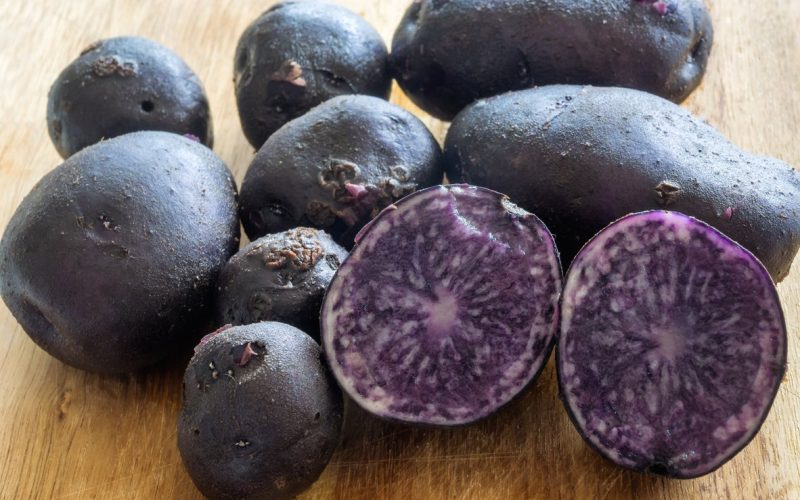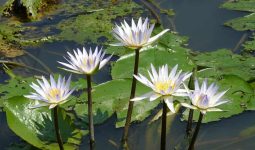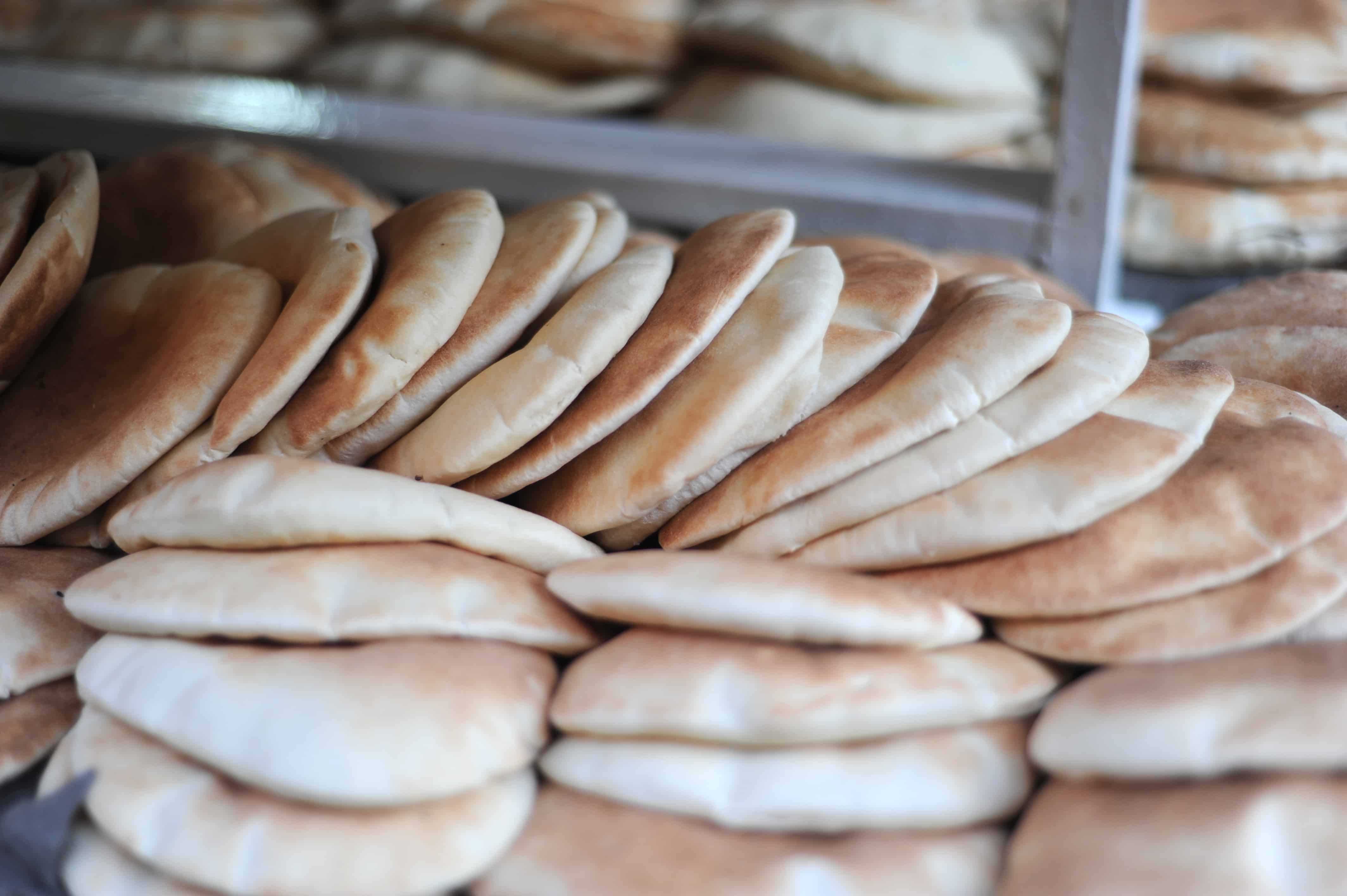Blue and purple potato varieties add vibrant colors to your meals and can make your dishes more appealing.
These eye-catching spuds, which include types like Purple Majesty and Blue Tomcat, are not just pretty but also nutritious.
You can cook them just like any other potato, whether you roast, mash, or fry them.
If you enjoy gardening, these potatoes can be a great addition to your vegetable patch.
Many types, such as Adirondack Blue and Huckleberry Gold, are hardy and adaptable.
They thrive in well-draining, fertile soil with plenty of sunlight. Some varieties also offer a unique taste and texture, making them a favorite among home cooks and chefs alike.
There’s a whole range of blue and purple potatoes to explore. From the vibrant Purple Viking with its striking skin to the creamy flesh of Magic Molly, each variety has something special to offer.
Dive into the world of colorful potatoes and discover how these versatile vegetables can brighten up your garden and kitchen.
1. Purple Pelisse

Purple Pelisse is a unique and flavorful potato variety. Originating from South America, these potatoes boast a striking purple color that remains vibrant even after cooking.
The bright purple hue comes from the anthocyanin pigments in the skin and flesh.
Purple Pelisse potatoes make fantastic chips. During an Oregon taste test, Purple Pelisse chips surpassed All Blue chips in color, appearance, and flavor.
These potatoes resist common issues like brown discoloration, which affects many other purple cultivars.
If you’re interested in growing Purple Pelisse, you can find seed growers online.
Key Characteristics
- Color: Deep purple
- Texture: Smooth skin with buttery flesh
- Taste: Rich and slightly nutty
- Cooking: Maintains color and texture well
Growing Conditions
- Light: Full sun (6-8 hours per day)
- Soil: Well-draining and fertile
- Hardiness Zones: 4-11
- Days to Maturity: 101-110
Purple Pelisse potatoes are a great addition to your garden. They offer beauty and a delicious, unique flavor that stands out among other purple and blue potato varieties.
When you grow these potatoes, you connect with a rich legacy from South America’s Andes Mountains.
You might also try growing other varieties like Adirondack Blue for a diverse and colorful harvest.
2. All Blue
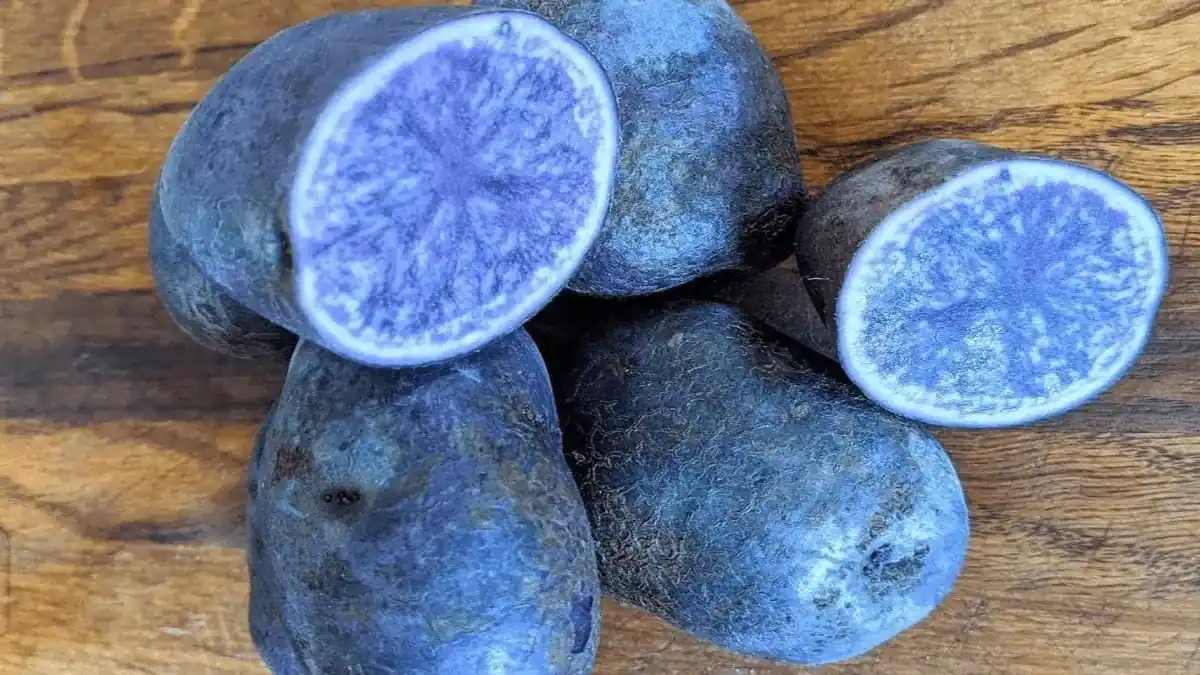
The All Blue potato is a striking variety with deep blue flesh and skin.
It’s an heirloom type, meaning it’s been around for a long time and is valued for its history and unique traits.
This is a great choice if you’re looking for a colorful addition to your garden or dinner plate.
Originally from the Andes Mountains in South America, All Blue potatoes are part of the rich heritage of Peruvian Purple and other Andean cultivars.
They thrive in well-drained, fertile soil and need full sun, about 6-8 hours daily.
One amazing feature of All Blue potatoes is their versatility. They are excellent for baking, boiling, and frying.
When cooked, the blue color remains vibrant, making your dishes look as good as they taste.
| Feature | Details |
|---|---|
| Origin | Andes Mountains, South America |
| Skin | Deep blue |
| Flesh | Blue |
| Uses | Baking, boiling, frying |
| Sunlight | Full sun, 6-8 hours a day |
| Soil | Well-drained, fertile |
Compared to other varieties like the Adirondack Blue, the All Blue potato has a more intense color and a slightly different flavor profile.
Enjoy growing this heirloom variety and add a splash of color to your meals!
3. Adirondack Blue
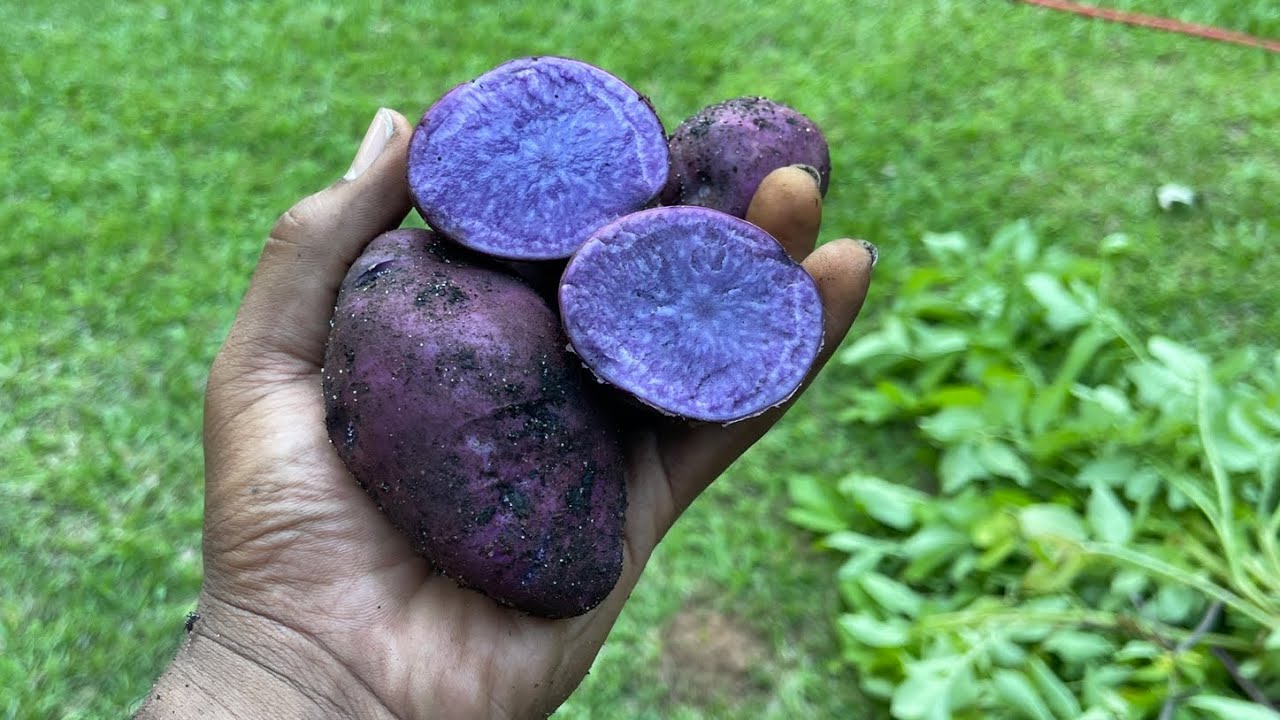
Adirondack Blue is an eye-catching potato variety with deep blue-purple coloration.
This cultivar stands out due to its vibrant hue, which stays even after cooking.
It was developed from old Peruvian Purple varieties in South America’s Andes Mountains.
Key Characteristics:
- Color: Blue-purple skin and flesh
- Size: Medium to large
- Texture: Smooth and firm
These stunning potatoes belong to the Solanaceae family and require well-draining, fertile soil to thrive.
Ensure you plant them in full sun, receiving about 6-8 hours of sunlight daily.
Growing Tips:
- Soil Preparation: Dig trenches or holes 4-6 inches deep.
- Spacing: Space seed potatoes 12-15 inches apart.
- Watering: Regular watering is crucial. Keep the soil moist but not soggy.
Adirondack Blue potatoes have a rich, earthy flavor. They are perfect for boiling, baking, or frying.
Their unique color makes them a great choice for adding visual appeal to your dishes.
Nutritional Benefits:
- High in antioxidants
- Rich in vitamins
- Low in fat and calories
The abundant antioxidants in these potatoes help boost your immune system.
Adding these colorful tubers to your diet can make your meals both nutritious and appealing.
For more details on growing and caring for Adirondack Blue potatoes, visit The Garden Magazine.
4. Vitelotte
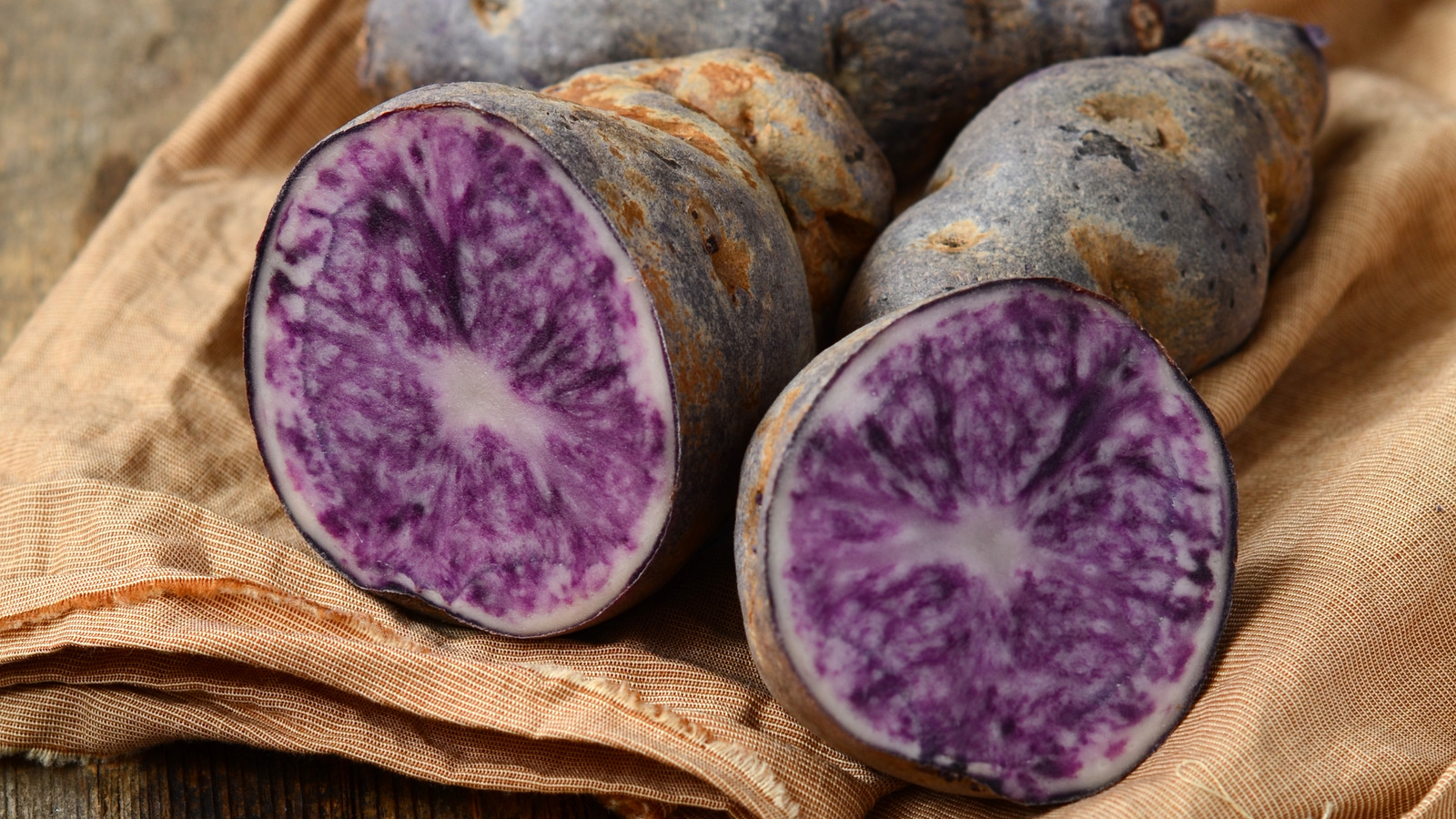
Vitelotte is a fascinating potato variety with a long history. This heirloom potato is known for its deep purple skin and flesh, which it retains even after cooking.
Originating from South America, specifically the Andes Mountains, it has been cultivated in Europe for hundreds of years.
Vitelotte potatoes are prized for their nutty flavor and firm texture, making them ideal for various dishes.
When you cook these potatoes, their rich color remains vibrant, adding an eye-catching element to your meals.
Key Characteristics
- Color: Deep purple skin and flesh
- Flavor: Nutty and earthy
- Texture: Firm
- Cooking Methods: Boiling, roasting, and frying
Nutritional Benefits
Vitelotte potatoes offer an array of nutrients, including antioxidants, which contribute to their vibrant color.
These potatoes are also a source of vitamins and minerals, making them a healthy choice for your diet.
Growing Vitelotte
If you plan to grow Vitelotte potatoes, they are well-suited for home gardens.
They thrive in well-draining soil and require full sun exposure for 6-8 hours per day.
- Mature Size: 24-36 inches
- Hardiness Zones: 4-11
- Days to Maturity: Approximately 110 days
Comparison with Other Cultivars
While Vitelotte shares similarities with other purple potato cultivars like Peruvian Purple and Adirondack Blue, its distinct nutty flavor and historical significance set it apart.
Each variety offers unique characteristics, providing diverse options for your culinary pursuits.
For more information, you can visit Live Eat Learn – Vitelotte.
5. Magic Molly
Magic Molly is one of the interesting blue and purple potato varieties you can try.
It’s a small to medium tuber, typically around 5 to 7 centimeters long, though some can grow up to 15 centimeters.
The potato has an elongated, oblong shape but can appear misshapen due to growing conditions. The skin of Magic Molly is semi-smooth and dark purple.
You’ll be happy to know that its flesh is a vibrant purple all the way through. This makes it eye-catching and fun to cook with.
Magic Molly matures about 95 to 100 days after planting if you’re into gardening.
It thrives best in well-draining, fertile soil and requires full sun for 6-8 hours a day.
Magic Molly shows some resistance to late blight and scab. Many gardeners appreciate its hardiness.
Magic Molly originated in the Andes Mountains of South America, similar to other purple potatoes like Peruvian Purple and Adirondack Blue.
- Nutrition: This variety, like other blue and purple potatoes, contains antioxidants, making it healthier than regular white potatoes.
- Usage in Cooking: You can prepare Magic Molly in various ways: mashed, fried, or roasted. The vibrant color remains even after cooking, making your dishes look unique.
You can check out suppliers like Fedco Seeds, which offer high-quality cultivars to get Magic Molly tubers.
With its striking color and good disease resistance, Magic Molly provides beauty and practicality for your garden and kitchen.
6. Peruvian Purple
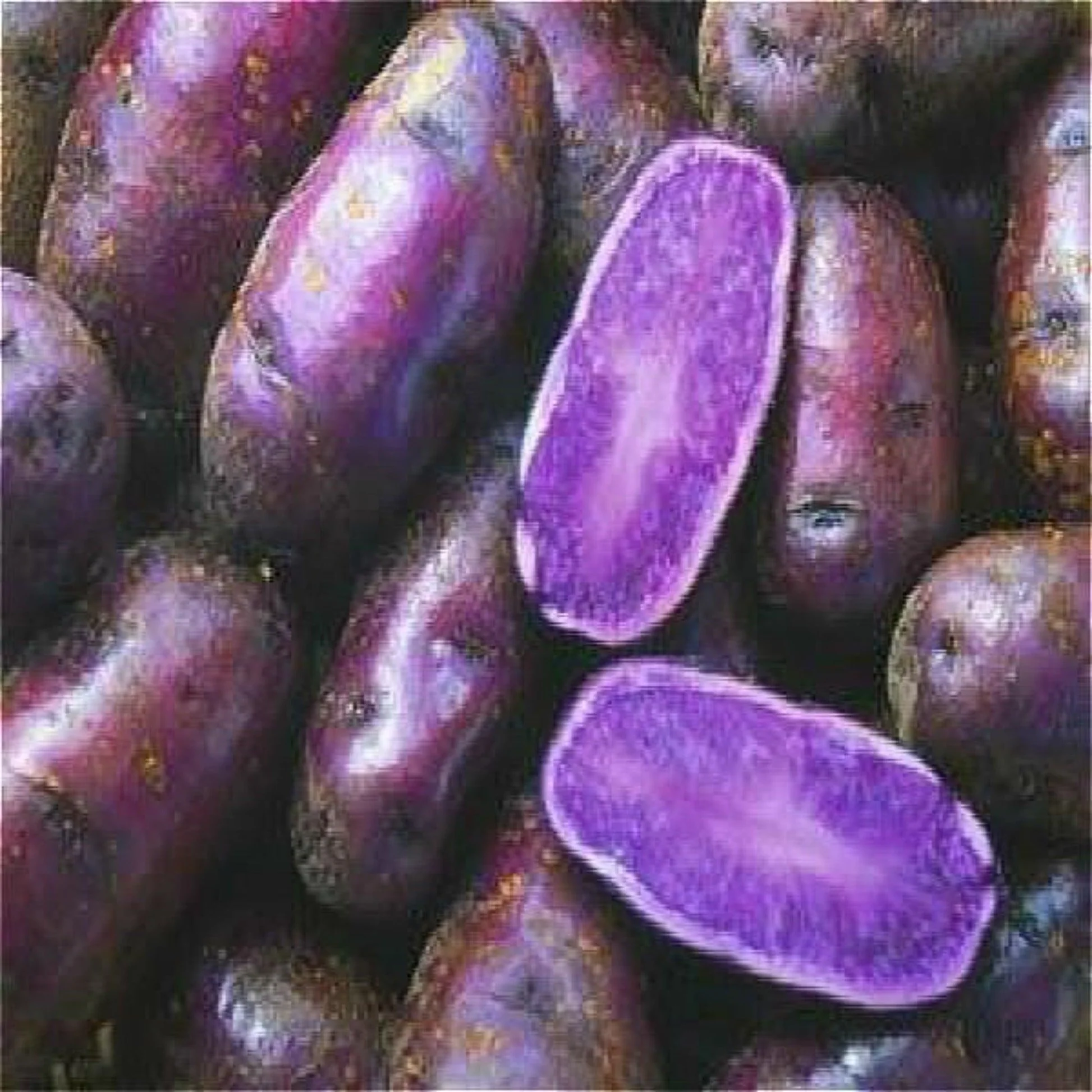
The Peruvian Purple potato is a fascinating heirloom variety from South America’s Andes Mountains.
This potato features vibrant, deep purple skin and flesh. It adds a striking color to any dish.
These potatoes have been grown in the Andes for centuries, making them one of the oldest potato cultivars.
You can plant Peruvian Purple potatoes just like other types. They thrive in well-draining, fertile soil and need around 90 to 120 days to harvest. Ensure they get plenty of sunlight and regular watering.
Peruvian Purple potatoes don’t just look pretty; they taste great, too. They have a unique, earthy flavor with a slightly nutty undertone.
They hold their shape well during cooking, making them perfect for salads or roasted dishes.
Compared to other blue and purple varieties like Adirondack Blue, Peruvian Purple potatoes are smaller but packed with flavor.
They maintain their color even after cooking, making your meals extra special.
Some quick facts
- Origin: Andes Mountains, South America
- Days to Maturity: 90-120 days
- Flavor: Earthy and nutty
- Best Use: Salads, roasting
Growing these heirloom potatoes in your garden can be both rewarding and tasty.
You’ll enjoy their vibrant color and flavor in your culinary creations.
Try them out and appreciate ancient agricultural history from the Andes.
7. Blaue (Blue) St. Galler

Blaue (Blue) St. Galler is a fascinating variety of potatoes that you should try growing.
Originating from a cross between Blaue Schweden and Prättigauer in Switzerland, this potato offers a unique culinary experience.
The cross was made back in 1995 in Flawil, Switzerland. This variety features long tubers with medium-depth eyes.
The skin and flesh are stunning blue, making any dish look vibrant and exotic. Imagine serving blue mashed potatoes at your next dinner!
Quick Facts
- Origin: Flawil, Switzerland
- Year of cross: 1995
- Parent cultivars: Blaue Schweden and Prättigauer
- Color: Blue skin and flesh
- Shape: Long with medium-depth eyes
Growing Tips
Growing Blaue St. Galler is as easy as growing more common potatoes like Adirondack Blue.
They prefer well-drained soil and full sunlight. Plant the tubers in spring, and you’ll harvest them in late summer.
Culinary Uses
The blue color of these potatoes holds up well during cooking. You can use them in a variety of dishes:
- Mashed potatoes: The blue color makes them a hit at parties.
- Roasted potatoes: A beautiful side dish.
- Salads: Add a burst of color to potato salads.
These potatoes are not just eye-catching; they’re delicious, too. The flavor is rich and earthy, reminiscent of Peruvian Purple potatoes from the Andes Mountains.
8. Purple Majesty
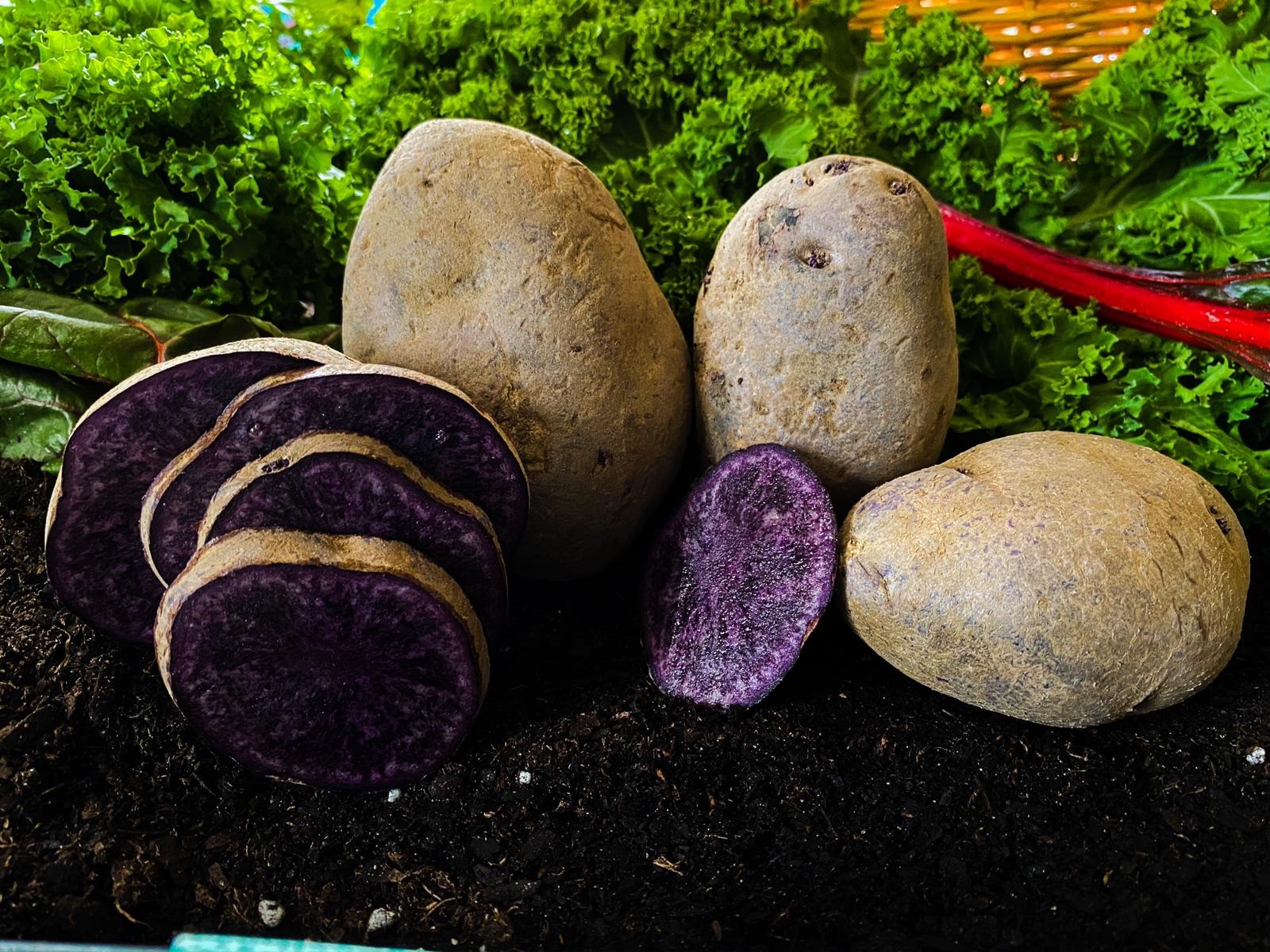
Purple Majesty potatoes are a vibrant choice for any kitchen. These tubers stand out due to their deep purple skin and flesh.
When you cook them, rest assured they will maintain their striking color.
These potatoes have a soft, buttery texture. This makes them ideal for a variety of dishes, from mashed potatoes to roasted delights.
You might find their taste richer and more complex than typical white potatoes.
Key Features of Purple Majesty
- Skin Color: Deep purple
- Flesh Color: Purple throughout
- Texture: Soft and buttery
Purple Majesty potatoes originated in South America, likely in the Andes Mountains.
This region is known as the birthplace of many potato cultivars.
They have become popular worldwide because of their striking color and delicious taste.
Among other heirloom varieties, Purple Majesty stands out. Adirondack Blue and Peruvian Purple are also well-known, but Purple Majesty has its unique charm.
You may notice hints of red wine in their skin, adding to their visual appeal.
Cooking Tips
- Roasting: Enhances their natural buttery flavor.
- Mashing: Keeps the purple color vibrant.
- Boiling: Retains its nutritional benefits.
Cultivating these potatoes is relatively easy. They grow best in well-drained, fertile soil with plenty of sunlight.
If you live in an area with a longer growing season, you can enjoy a bountiful harvest of these colorful gems.
For more information on other remarkable varieties like Purple Majesty, you can visit Gardener’s Path.
9. Blue Tomcat
‘Blue Tomcat’ is an exciting heirloom potato you should consider for your garden. This variety stands out for its rich color and unique taste.
With skin and flesh that are both very dark blue, it adds visual appeal to your dishes.
You can expect this potato to mature late in the growing season.
Growing Requirements
- Hardiness Zones: 4-11
- Light: Full sun, 6-8 hours per day
- Soil: Well-draining, fertile
- Mature Size: 24-36 inches tall
- Days to Maturity: 101-110 days
Tips for Planting Blue Tomcat
Ensure you plant them in a spot where they receive plenty of sunlight.
You’ll need rich soil that drains well. Their long growing season means you might have to wait a bit, but the results are worth it.
Origin and Characteristics
This variety is part of a group of colorful potatoes that come from the Andes Mountains in South America.
The vibrant hues are due to anthocyanin pigments found in both the skin and flesh.
Like the Adirondack Blue and Purple Peruvian, ‘Blue Tomcat’ offers both beauty and nutrition.
Consider adding ‘Blue Tomcat’ to your planting list. Its striking appearance and delicious flavor make it a unique choice among potato cultivars.




